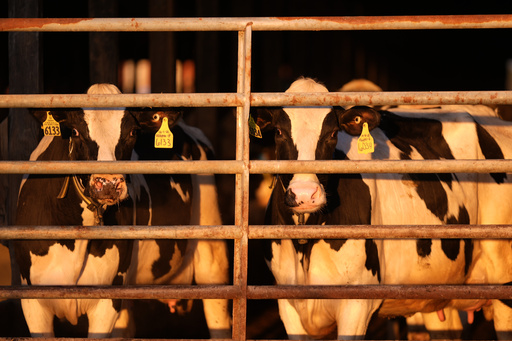U.S. health and agriculture officials pledged nearly $200 million in new spending and other efforts Friday to help track and contain an outbreak of bird flu in the nation’s dairy cows that has spread to more than 40 herds in nine states.
The new funds include $101 million to continue work to prevent, test, track and treat animals and humans potentially affected by the virus known as Type A H5N1, the U.S. Department of Health and Human Services said. And they include about $98 million to provide up to $28,000 each to help individual farms test cattle and bolster biosecurity efforts to halt the spread of the virus, according to the Agriculture Department.
In addition, dairy farmers will be compensated for the loss of milk production from infected cattle, whose supply drops dramatically when they become sick, officials said. And dairy farmers and farm workers would be paid to participate in a workplace study conducted by the USDA and the Centers for Disease Control and Prevention.
So far, farmers have been reluctant to allow health officials onto their farms to test cattle because of uncertainty about how it would affect their businesses, researchers have said. Also, farm workers, including many migrant workers, have been reluctant to be tested for fear of missing work or because they didn’t want to be tracked by the government.
The National Milk Producers Federation, a trade group representing dairy farmers, said they welcomed the new resources. “Care for farm workers and animals is critical for milk producers, as is protecting against potential human health risks and reassuring the public,” the group said in a statement.
The incentives should help increase farmers’ willingness to test their herds, said Keith Poulsen, director of the Wisconsin Veterinary Diagnostic Laboratory, who has been monitoring the outbreak.
“It provides the latitude and capacity to start going in the right direction,” he said.
The new spending comes more than six weeks after the first-ever detection of an avian bird flu virus in dairy cattle — and one confirmed infection in a Texas dairy worker exposed to infected cows who developed a mild eye infection and then recovered. About 33 people have been tested and another 260 are being monitored, according to the CDC.
As of Friday, 42 herds in nine states have confirmed infections in dairy cows. Agriculture Secretary Tom Vilsack said that the outbreak has not spread more widely.
“It’s still in the same nine states and that’s the most positive thing about where we are,” he told reporters.
Samples of grocery store milk tested by the U.S. Food and Drug Administration showed remnants of the virus in about 1 in 5 samples of retail milk nationwide, however, suggesting that the outbreak could be more widespread, scientists have said.
Under a federal order issued last month, farmers are required to test lactating dairy cattle for H5N1 before the animals are moved between states. The Agriculture Department said Friday that 112 out of 905 tests conducted between April 29 and May 5 by federal animal health laboratories appeared to be positive. Officials could not say how many cows tested positive because multiple samples may have been collected from a single cow. Labs are conducting about 80 more tests per day than before the order took effect, an Agriculture Department spokesman said.
About 50,000 dairy cattle typically cross state lines every week, Poulsen estimates.
The FDA found that pasteurization, or heat-treating, killed the virus in the grocery samples of milk, cottage cheese and sour cream. The agency reiterated warnings that people should not consume raw, or unpasteurized milk, because of possible risk from the virus. Officials on Friday also said they expect results soon from tests of pooled raw milk samples sent to commercial processors to “determine potential levels of virus that pasteurization must eliminate.” The USDA found no evidence of the virus in a small sample of retail ground beef.
“The risk to the public from this outbreak remains low,” Health and Human Services Secretary Xavier Becerra said.
___
This story has been updated to clarify the count of H5N1 test results in U.S. cattle. The Agriculture Department initially told reporters 80 cows were tested between April 29 and May 5. The department later said it collected 905 samples, and that 112 appeared to be positive. It could not provide the number of cows tested because multiple samples may have been collected from a single cow.
___
The Associated Press Health and Science Department receives support from the Howard Hughes Medical Institute’s Science and Educational Media Group. The AP is solely responsible for all content.
